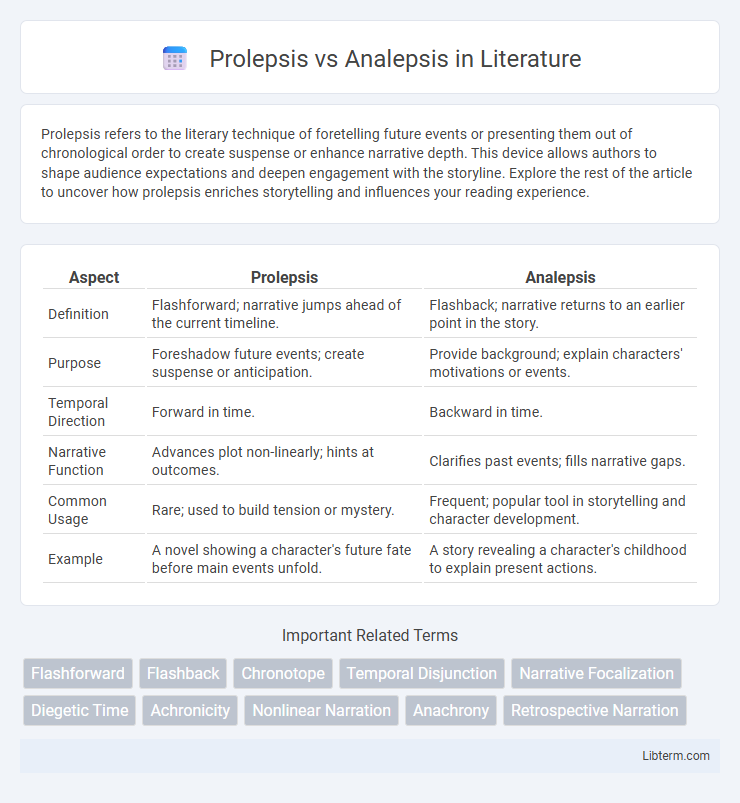Prolepsis refers to the literary technique of foretelling future events or presenting them out of chronological order to create suspense or enhance narrative depth. This device allows authors to shape audience expectations and deepen engagement with the storyline. Explore the rest of the article to uncover how prolepsis enriches storytelling and influences your reading experience.
Table of Comparison
| Aspect | Prolepsis | Analepsis |
|---|---|---|
| Definition | Flashforward; narrative jumps ahead of the current timeline. | Flashback; narrative returns to an earlier point in the story. |
| Purpose | Foreshadow future events; create suspense or anticipation. | Provide background; explain characters' motivations or events. |
| Temporal Direction | Forward in time. | Backward in time. |
| Narrative Function | Advances plot non-linearly; hints at outcomes. | Clarifies past events; fills narrative gaps. |
| Common Usage | Rare; used to build tension or mystery. | Frequent; popular tool in storytelling and character development. |
| Example | A novel showing a character's future fate before main events unfold. | A story revealing a character's childhood to explain present actions. |
Understanding Prolepsis and Analepsis
Prolepsis and analepsis are narrative techniques used to manipulate the chronological order of a story, with prolepsis referring to a flashforward that reveals future events, and analepsis denoting a flashback that revisits past moments. Understanding prolepsis involves recognizing how authors foreshadow developments to create suspense or thematic depth, while grasping analepsis requires analyzing how backstories enrich character motivations and plot complexity. Mastery of these devices enhances comprehension of literary structure and narrative strategy in storytelling.
Etymology and Definitions
Prolepsis derives from the Greek word "prolepsis," meaning "anticipation," and refers to a narrative technique where future events are recounted before their chronological occurrence. Analepsis, originating from the Greek "analepsis," meaning "re-taking" or "recovery," signifies a flashback or a return to an earlier point in the story. These terms are fundamental in literary theory to describe temporal shifts in storytelling.
Key Differences Between Prolepsis and Analepsis
Prolepsis, also known as flashforward, involves narrating events that will occur later in the storyline, creating anticipation by revealing future actions or outcomes. Analepsis, or flashback, interrupts the chronological flow to provide background information about past events, enhancing character development and plot understanding. The key difference lies in their temporal direction: prolepsis projects forward to future events, while analepsis looks backward to past moments within the narrative structure.
Functions in Narrative Structure
Prolepsis serves to foreshadow future events, creating suspense and anticipation within the narrative structure. Analepsis functions to provide background information or context, enhancing character development and deepening the reader's understanding of past events. Both techniques manipulate chronological order to enrich the story's complexity and emotional impact.
Examples of Prolepsis in Literature
Prolepsis, or flash-forward, appears in literature through examples like Shakespeare's "Macbeth," where the witches' prophecy predicts Macbeth's rise and fall, setting future events early in the narrative. In Gabriel Garcia Marquez's "One Hundred Years of Solitude," prolepsis occurs when the narrator reveals the doomed fate of the Buendia family generations ahead of the plot's present moment. These instances of prolepsis enhance foreshadowing, intensify suspense, and deepen readers' engagement with the unfolding story.
Examples of Analepsis in Literature
Analepsis, commonly known as a flashback, appears frequently in literature to provide background or context by interrupting the chronological sequence of events. Notable examples include the vivid childhood memories in Marcel Proust's "In Search of Lost Time," the recurring flashbacks in William Faulkner's "The Sound and the Fury," and the pivotal recollections in Gabriel Garcia Marquez's "One Hundred Years of Solitude." These analeptic moments deepen character development and enrich narrative complexity by revealing past experiences influencing present events.
Impact on Reader Experience
Prolepsis and analepsis shape narrative structure by manipulating time flow, with prolepsis offering glimpses of future events that build suspense and anticipation. Analepsis, or flashbacks, enrich character development and context by revealing past information that deepens understanding and emotional resonance. Together, these techniques engage readers by creating complex, layered storytelling that maintains interest and enhances emotional investment.
Common Misconceptions
Prolepsis and analepsis are often confused due to their roles in narrative time shifts; prolepsis refers to a flash-forward, while analepsis denotes a flashback. Common misconceptions include mistaking prolepsis as merely foreshadowing, but it specifically presents future events out of chronological order. Analepsis is frequently oversimplified as simple memory recall, whereas it strategically reveals past events to enhance plot depth and character understanding.
Prolepsis and Analepsis in Modern Storytelling
Prolepsis, or flash-forward, projects future events into the narrative, creating suspense and foreshadowing outcomes, while analepsis, or flashback, reveals past moments to provide context and depth to characters or plotlines. Modern storytelling frequently utilizes prolepsis to engage audiences by teasing climactic scenes, often seen in TV dramas and novels to heighten anticipation. Analepsis remains essential in contemporary narratives for character development and clarifying motivations, enriching the story's emotional impact and coherence.
Tips for Writers: Using Prolepsis and Analepsis Effectively
Writers can enhance narrative depth by strategically using prolepsis, or flash-forward, to build suspense and foreshadow key events, while analepsis, or flashback, effectively provides essential backstory without disrupting the main timeline. Maintaining clarity in time shifts is crucial; signaling transitions through clear temporal markers or changes in tense helps readers navigate the chronology smoothly. Balancing these techniques prevents confusion and enriches character development by revealing motivations and future consequences in a controlled, impactful manner.
Prolepsis Infographic

 libterm.com
libterm.com